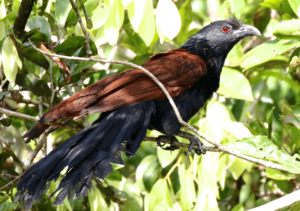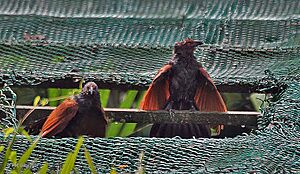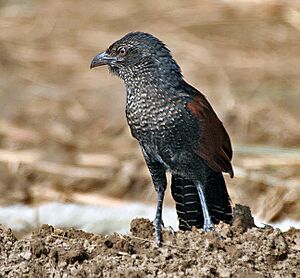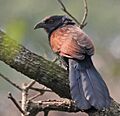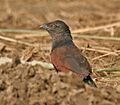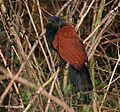Greater coucal facts for kids
Quick facts for kids Greater coucal |
|
|---|---|
 |
|
| Conservation status | |
| Scientific classification | |
| Genus: |
Centropus
|
| Species: |
sinensis
|
The greater coucal or crow pheasant (Centropus sinensis) is a large bird. It belongs to the cuckoo family, but unlike some cuckoos, it does not lay its eggs in other birds' nests. These birds live across the Indian Subcontinent and Southeast Asia. There are several types, or subspecies, of greater coucals.
Greater coucals look a bit like crows, with long tails and shiny coppery-brown wings. You can find them in many places, from thick jungles to farms and even city gardens. They are not very strong fliers. You'll often see them climbing through plants or walking on the ground. They search for insects, eggs, and even baby birds to eat. They have a deep, booming call that many people believe brings good or bad luck.
Contents
What Does a Greater Coucal Look Like?

This is a large cuckoo, about 48 centimeters (19 inches) long. Its head, upper back, and belly are black with a purple shine. Its back and wings are a rich chestnut brown. The eyes are a bright ruby red.
Young coucals look a bit different. They are a duller black with spots on their heads. They also have whitish stripes on their bellies and tails.
There are different types of greater coucals depending on where they live. These groups are called "races" or "subspecies." Some scientists even think some of these races might be separate species! For example, the type found in southern India has a black head and blue-shiny underparts. Its forehead and throat are more brownish. Male and female coucals look similar, but females are usually a bit bigger.
Sometimes, you might see a coucal that is unusually pale. This is due to a condition called Leucism.
Different Kinds and Where They Live
The main type of greater coucal lives from the Indus Valley, through the Himalayan foothills and plains, into Nepal, Assam, Bhutan, and southern China.
Other types live in different areas:
- One type, parroti, lives in Peninsular India. Its upper back is black, and young birds do not have stripes on their wings.
- Another type, intermedius, is smaller. It lives in Bangladesh, Myanmar, China, Thailand, and parts of Malaysia.
- The bubutus type lives in southern Malaysia and islands like Sumatra, Java, and Borneo. Its wings are a lighter reddish-brown.
- The anonymus type is found in the southwestern Philippines. It has shorter, darker wings than bubutus.
- The kangeangensis type lives on the Kangean Islands. These birds can have both light and dark feathers.
When baby coucals hatch, they have black skin and white, hair-like feathers around their eyes and beak. Their belly is pinkish.
What Do Greater Coucals Do?
Greater coucals eat many different things. They catch a wide range of insects, caterpillars, and snails. They also eat small animals like snakes. Sometimes, they eat bird eggs, baby birds, fruits, and seeds. In some areas, they are known to eat snails. They can even eat the poisonous fruits of the Yellow Oleander plant! In places where oil palm trees are grown, coucals sometimes eat the fruit, which can make them a pest.
In the mornings, you might see them sunbathing. They spread their wings out on top of plants, either alone or in pairs. They are most active in the warm parts of the morning and late afternoon.
Their calls are a deep, booming "coop-coop-coop" sound that they repeat. Sometimes, a male and female will call together. The female's call is usually lower pitched. They also make a fast rattling sound and a harsh, scolding noise.
Reproduction and Family Life
Greater coucals usually breed after the rainy season in southern India. In other places, the breeding time can vary, but it's often from June to September.
These birds stay with one partner. During courtship, the male will chase the female on the ground. He also brings her food as a gift. The female shows she accepts him by lowering her tail and drooping her wings.
The male does most of the nest building. It takes about three to eight days to build. The nest is a deep cup shape with a dome on top. They build it in thick plants, like bamboo or tangled vines. Nests can be as high as 6 meters (20 feet) off the ground.
A female usually lays 3 to 5 eggs. The eggs are chalky white with a yellowish shine when first laid. Both the male and female help build the nest. They lay 2 to 4 eggs, which hatch after 15–16 days. The young birds are ready to leave the nest after 18–22 days.
Sometimes, other birds like the Indian jungle crow might raid their nests.
Greater Coucals in Culture
Many people have special beliefs about the greater coucal. Its deep calls are sometimes thought to be connected to spirits or to bring good or bad luck. In some parts of India, people used to believe that a certain type of snake mated with male greater coucals.
Long ago, when British people first came to India, they sometimes mistook the coucal for a pheasant and tried to hunt it. But they quickly found that its meat tasted "evil," so they nicknamed it "Griff's pheasant."
In the past, some people ate the coucal's meat as a folk remedy for lung problems.
Images for kids
-
at Narendrapur near Kolkata, West Bengal, India
-
at Narendrapur near Kolkata, West Bengal, India
-
In Kolkata, West Bengal, India
-
In Kolkata, West Bengal, India
-
At Rabindra Sarobar, Kolkata



